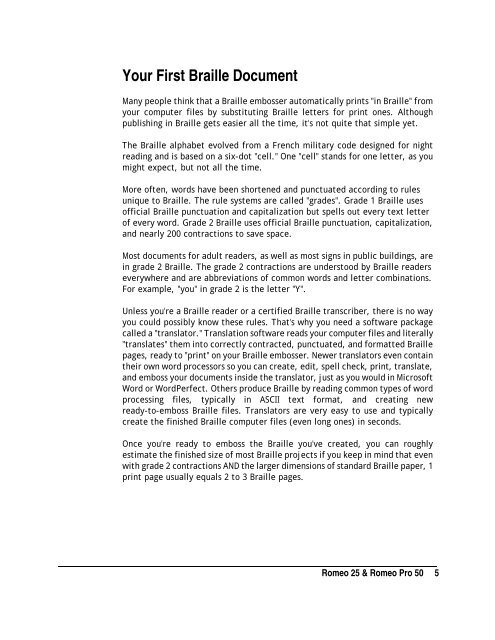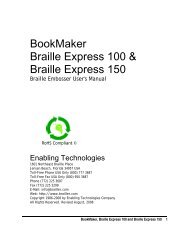Romeo 25 & Romeo Pro 50 - Enabling Technologies
Romeo 25 & Romeo Pro 50 - Enabling Technologies
Romeo 25 & Romeo Pro 50 - Enabling Technologies
You also want an ePaper? Increase the reach of your titles
YUMPU automatically turns print PDFs into web optimized ePapers that Google loves.
Your First Braille Document<br />
Many people think that a Braille embosser automatically prints "in Braille" from<br />
your computer files by substituting Braille letters for print ones. Although<br />
publishing in Braille gets easier all the time, it's not quite that simple yet.<br />
The Braille alphabet evolved from a French military code designed for night<br />
reading and is based on a six-dot "cell." One "cell" stands for one letter, as you<br />
might expect, but not all the time.<br />
More often, words have been shortened and punctuated according to rules<br />
unique to Braille. The rule systems are called "grades". Grade 1 Braille uses<br />
official Braille punctuation and capitalization but spells out every text letter<br />
of every word. Grade 2 Braille uses official Braille punctuation, capitalization,<br />
and nearly 200 contractions to save space.<br />
Most documents for adult readers, as well as most signs in public buildings, are<br />
in grade 2 Braille. The grade 2 contractions are understood by Braille readers<br />
everywhere and are abbreviations of common words and letter combinations.<br />
For example, "you" in grade 2 is the letter "Y".<br />
Unless you're a Braille reader or a certified Braille transcriber, there is no way<br />
you could possibly know these rules. That's why you need a software package<br />
called a "translator." Translation software reads your computer files and literally<br />
"translates" them into correctly contracted, punctuated, and formatted Braille<br />
pages, ready to "print" on your Braille embosser. Newer translators even contain<br />
their own word processors so you can create, edit, spell check, print, translate,<br />
and emboss your documents inside the translator, just as you would in Microsoft<br />
Word or WordPerfect. Others produce Braille by reading common types of word<br />
processing files, typically in ASCII text format, and creating new<br />
ready-to-emboss Braille files. Translators are very easy to use and typically<br />
create the finished Braille computer files (even long ones) in seconds.<br />
Once you're ready to emboss the Braille you've created, you can roughly<br />
estimate the finished size of most Braille projects if you keep in mind that even<br />
with grade 2 contractions AND the larger dimensions of standard Braille paper, 1<br />
print page usually equals 2 to 3 Braille pages.<br />
<strong>Romeo</strong> <strong>25</strong> & <strong>Romeo</strong> <strong>Pro</strong> <strong>50</strong> 5









